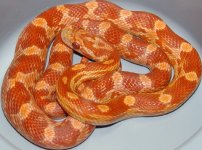Serpwidgets
New member
These were posted early on in the Ultra Mystery thread, and there have been quite a few more since.


I personally ignore the results given by Shivers because he has never shown any indication that he notices the difference between ultras and ultramels.
Ignoring Shivers results (which still are not inconsistent with ultramel and thus none of which could be suggested as disproof either) there are still 17 crosses in that sheet.
If each snake that was amel or het amel had a 50/50 chance of being het for a non-allelic ultra, and each non-amel or non-het also had a 50/50 chance of being not het for a non-allelic ultra, the odds of the above results occuring would be on the order of 1 in 131,000. That was when I stopped counting.
Add to that pile of numbers our Ultramel male. He was produced from Ultra X Butter Motley. His offspring when crossed to a Charcoal het Amel were normals, ultramels, and amels, in the expected ratio of course.
I don't believe we've included any of Mike Panichi's results in there. His results of crossing golddust or ultra caramel X golddust or ultra caramel have all produced non-normal offspring.
If there is insufficient proof to treat them as alleles, then what alternative can you suggest that is consistent with all of the above? (Since Ultramel IS consistent with all of them, anything better will also have to be consistent, too.)
How will this alternative's predictions vary from the results given by treating them as alleles?
How likely will the result be to vary from those given by ultramel?
How will the amount of variation between the two alternatives compare to the amount of standard variation in clutches from just plain "luck?" That is, even if ultramel were replaced by a "better" model, how many crosses would be required before anyone could even quantify that one alternative is a "better" answer than the other?


I personally ignore the results given by Shivers because he has never shown any indication that he notices the difference between ultras and ultramels.
Ignoring Shivers results (which still are not inconsistent with ultramel and thus none of which could be suggested as disproof either) there are still 17 crosses in that sheet.
If each snake that was amel or het amel had a 50/50 chance of being het for a non-allelic ultra, and each non-amel or non-het also had a 50/50 chance of being not het for a non-allelic ultra, the odds of the above results occuring would be on the order of 1 in 131,000. That was when I stopped counting.
Add to that pile of numbers our Ultramel male. He was produced from Ultra X Butter Motley. His offspring when crossed to a Charcoal het Amel were normals, ultramels, and amels, in the expected ratio of course.
I don't believe we've included any of Mike Panichi's results in there. His results of crossing golddust or ultra caramel X golddust or ultra caramel have all produced non-normal offspring.
If there is insufficient proof to treat them as alleles, then what alternative can you suggest that is consistent with all of the above? (Since Ultramel IS consistent with all of them, anything better will also have to be consistent, too.)
How will this alternative's predictions vary from the results given by treating them as alleles?
How likely will the result be to vary from those given by ultramel?
How will the amount of variation between the two alternatives compare to the amount of standard variation in clutches from just plain "luck?" That is, even if ultramel were replaced by a "better" model, how many crosses would be required before anyone could even quantify that one alternative is a "better" answer than the other?

